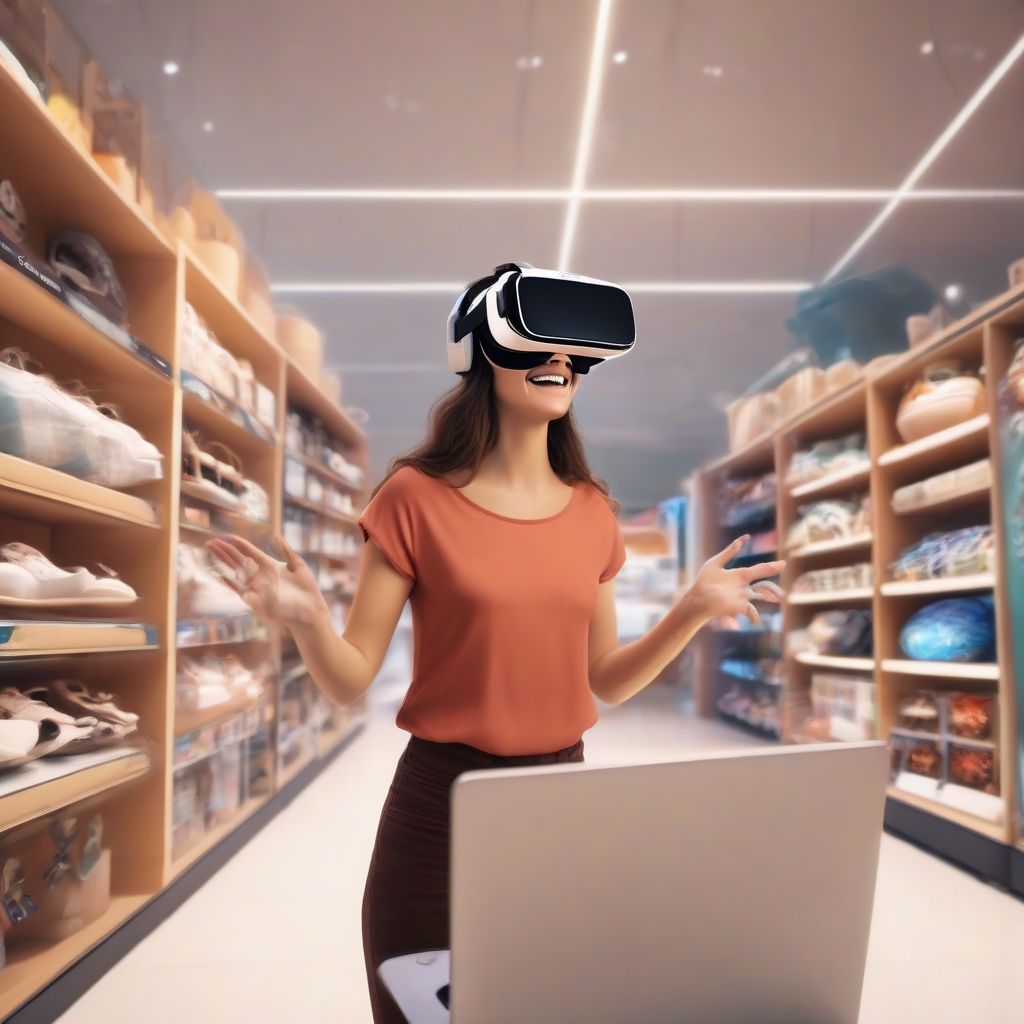Imagine stepping into a store, not through a physical door, but through a virtual portal. You browse aisles, interact with products, and even try on clothes, all from the comfort of your living room. This is the promise of virtual reality (VR) and its potential to revolutionize how we shop and interact with brands.
As a nutritionist and meal prep coach, I’ve seen firsthand how technology can transform healthy habits. Now, VR is poised to transform the entire shopping experience, from browsing to purchasing. Let’s dive into the fascinating ways VR is shaping consumer behavior and creating new possibilities for businesses and shoppers alike.
Experiential Retail: Stepping into the Future of Shopping
VR’s impact on consumer behavior stems from its ability to create immersive experiences that transcend the limitations of traditional shopping. Here’s how VR is changing the game:
1. Breaking Down Physical Barriers: From Couch to Boutique
One of the most significant impacts of VR is its ability to bridge the gap between online and offline shopping. Consumers no longer have to choose between the convenience of online shopping and the tangible experience of visiting a physical store.
-
Virtual storefronts allow customers to virtually walk through a store, browse products in 3D, and experience the look and feel of a brand without leaving their homes.
-
For example, IKEA Place, a VR app, allows customers to visualize how furniture would look and fit in their homes before making a purchase. This immersive experience minimizes uncertainty and encourages confident buying decisions.
2. Engaging the Senses: A Feast for the Eyes and Beyond
Unlike traditional online shopping, which relies heavily on static images and descriptions, VR engages multiple senses, leading to a more emotionally engaging and memorable experience.
-
Imagine trying on clothes virtually, feeling the texture of fabrics, and seeing how an outfit moves with your body, all without physically wearing the garments. This level of sensory engagement leads to increased purchase confidence and reduces buyer’s remorse.
-
VR can also transport shoppers to exotic locations to experience a product firsthand. Imagine exploring a coffee plantation in Colombia through VR before purchasing your next bag of beans. This immersive experience creates a powerful connection between the consumer and the product.
 VR shopping experience
VR shopping experience
3. Personalization: Tailoring the Shopping Journey
VR opens doors for highly personalized shopping experiences tailored to individual preferences and needs. This level of customization fosters a sense of connection and loyalty between consumers and brands.
-
Imagine entering a virtual store and being greeted with personalized recommendations based on your past purchases and preferences.
-
VR can also be used to create personalized product demonstrations and tutorials. For example, a customer interested in a new kitchen appliance could receive a virtual demonstration tailored to their specific needs and skill level.
The Impact on Consumer Behavior: A New Era of Engagement
The immersive and interactive nature of VR directly influences consumer behavior, leading to increased engagement, brand loyalty, and ultimately, sales.
1. Increased Engagement and Time Spent: Dwelling in the Details
VR experiences naturally encourage consumers to spend more time engaging with brands and products. This increased dwell time translates to greater brand exposure and a deeper understanding of product offerings.
- Interactive elements within VR experiences, such as games, quizzes, and virtual tours, further enhance engagement. For example, a car manufacturer could create a VR experience that allows users to virtually test drive a new model on a scenic route, gamifying the experience and leaving a lasting impression.
2. Enhanced Brand Perception and Loyalty: Forging Emotional Connections
By providing unique and memorable experiences, VR can positively influence brand perception and foster long-term customer loyalty.
- Imagine attending a virtual concert hosted by your favorite clothing brand or participating in a cooking class led by a renowned chef sponsored by a food company. These experiences create a sense of community and forge emotional connections that go beyond traditional marketing efforts.
3. Increased Purchase Confidence: Minimizing Uncertainty
The immersive nature of VR minimizes uncertainty and empowers consumers to make more informed purchasing decisions.
-
Virtual try-on experiences for clothing and accessories allow consumers to assess fit, style, and overall look, reducing the likelihood of returns and exchanges.
-
In the food industry, imagine being able to virtually experience the texture and taste of a new food product before buying it. This could revolutionize how consumers approach unfamiliar ingredients and dishes.
[amazon bestseller=”virtual reality headset”]
The Future of VR in Retail: A Glimpse Ahead
While still in its early stages, VR has the potential to reshape the retail landscape significantly. As technology advances and becomes more accessible, we can expect to see even more innovative applications emerge.
-
The integration of augmented reality (AR) with VR will further blur the lines between the physical and digital worlds. Imagine using your smartphone to scan a product on a shelf and then being transported to a VR experience that provides additional information, reviews, or even virtual try-on capabilities.
-
Social VR experiences will enable friends to shop together in virtual environments, replicating the social aspect of traditional shopping. This creates opportunities for brands to engage with multiple consumers simultaneously and build communities around their products.
Conclusion: Embracing the VR Revolution
The impact of VR on consumer behavior and shopping experiences is undeniable. By creating immersive, engaging, and personalized experiences, VR is transforming how we discover, interact with, and purchase products. As technology continues to evolve, VR will play an increasingly important role in shaping the future of retail, offering exciting possibilities for both businesses and consumers alike.
Are you ready to embrace the VR revolution? Share your thoughts in the comments below!
